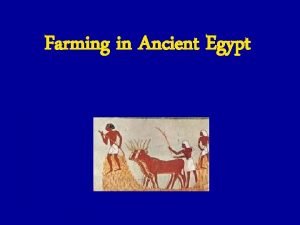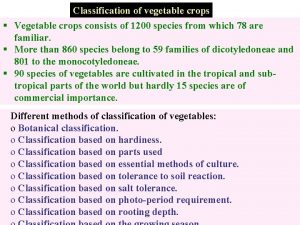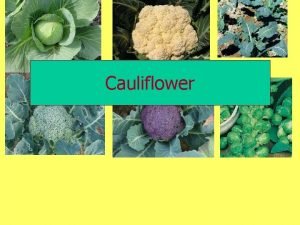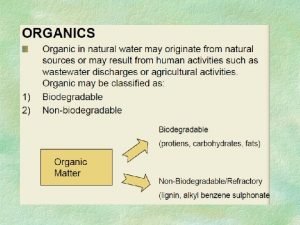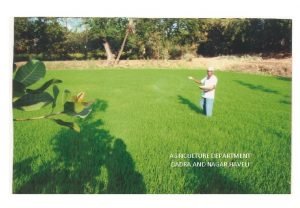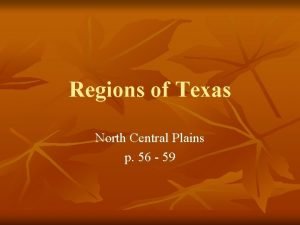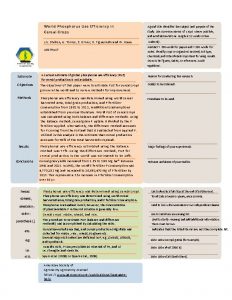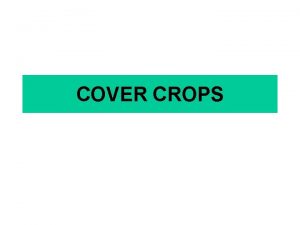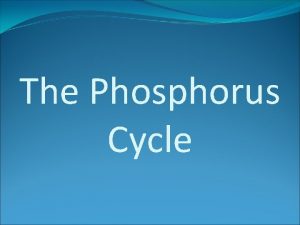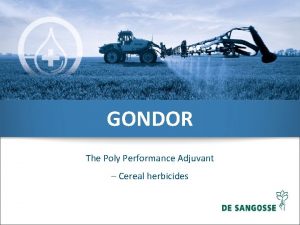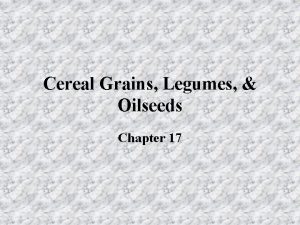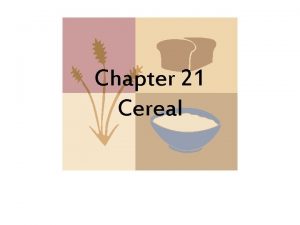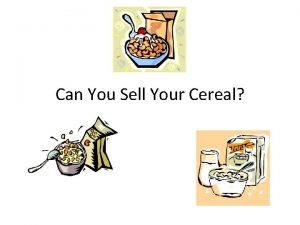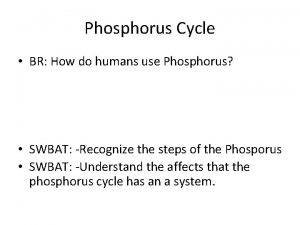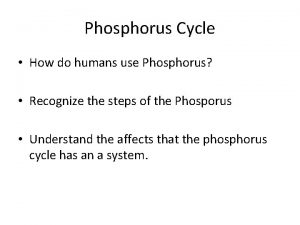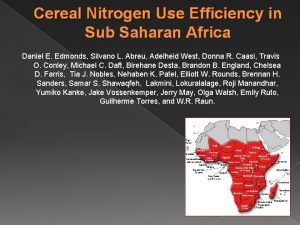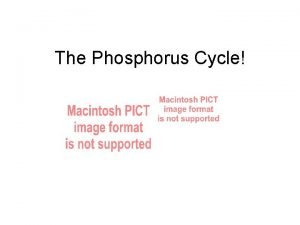World Phosphorus Use Efficiency in Cereal Crops Jagman


















- Slides: 18

World Phosphorus Use Efficiency in Cereal Crops Jagman Dhillon, Guilhereme Torres, Ethan Driver, Bruno Figueiredo, and William Raun August 8, 2017 15 th Annual NUE Conference, LSU. Dhillon, J. , G. Torres, E. Driver, B. Figueiredo, and W. R. Raun. 2017. World Phosphorus Use Efficiency in Cereal Crops. Agron. J. 109: 1670 -1677. doi: 10. 2134/agronj 2016. 08. 0483

Introduction �Phosphorus is the second most limiting nutrient in crop production �Essential component of ◦ Adenosine triphosphate (ATP), energy currency that drives most biochemical processes ◦ Deoxyribonucleic acid (DNA), seat of genetic inheritance ◦ Ribonucleic acid (RNA), direct protein synthesis in both plants and animals ◦ Phospholipids, critical role in cellular membrane

�Nearly 67% of land designated for crop production is P deficient (Batjes 1997) �Soil orders with potential P deficiency account for 51% of the world soils (Brady and Weil, 2008) Data from Baligar et al. (2001)

Soil P Cycle Plant Uptake Root uptake Residue return to the soil Form 3 – Soluble Soil Solution < 1% Immobilization “Tie-up” Microbial Mineralization Activity Form 1 – Organic matter 40 -60% Adsorption “Tie-up” Weathering Solubility Form 2 – Inorganic Mineral compounds 40 -60%

�Plant available P concentration is low (0. 1 – 10 µM) �For optimal production P fertilizers are required ◦ Phosphorus mining �Different accounts for life-span of phosphate reserves P reserves (Years till extinction) Reference 50 -100 Smil (2000) 343 Robert and Stewart (2002) 100 Heffer et al. (2006) 300 -400 IFDC (2010) 300 Van Kauwenbergh et al. (2013)

�When P is applied as fertilizer, it quickly becomes unavailable �Only 10 to 15% is available for uptake (within yr) �Developed countries have overused P resulting in environmental pollution (eutrophication, lakes and streams) �Developing countries underuse P fertilizers resulting in Land Degradation Brady and Weil, 2008

Objective �To estimate global P use efficiency for cereal crops �To review methods for improvement of PUE

Materials and Methods �Fifty-three years of world cereal harvested area, cereal production, and world fertilizer P consumption data was obtained from the FAOSTAT database. �Cereal crops included maize, rice, wheat, sorghum, barley, millet, oats, rye, triticale, canary seeds, buckwheat, mixed grains, and quinoa. �P uptake of cereal grain was calculated using crop specific grain P content obtained from the United States Department of Agriculture (USDA). �‘summary’ and ‘means’ procedures in SAS were used to calculate descriptive statistics.

�P use efficiency was calculated using �Balance method ◦ ������ _�� =(������ �� ������ )/(�� �������� ������������ )∗ 100 �Difference method ◦ ������ _�� =(������ �� ������ −�� ������ �� ℎ�� ���� )/(�� ��������� ���� �� ���������� )∗ 100 �P removed in the grain coming from the soil was calculated by multiplying the total cereal grain P removed by 79. 3%. This value was based on P fertilizer recovery of 20. 7% reported in various studies using difference and direct methods.

Results Table 1. World harvested area, consumption of P fertilizers for cereal production, P removed in the grain and estimated P use efficiency over 53 Years (FAO, 2016). Variables and Computation A B F G H Upper 126, 856, 918 147, 111, 618 223, 143, 009 46, 141, 576 69, 508, 320 39, 379, 592 21, 577, 297 16, 977, 957 1, 768, 731 7, 421, 313 699, 886, 332 1, 157, 388, 060 60 17, 288, 945 11, 199, 989 991, 413, 624 737, 564, 302 711, 142, 394 178, 074, 020 77, 567, 348 34, 814, 105 54, 506, 300 38, 193, 583 15, 833, 430 18, 752, 739 2, 857, 861, 845 3, 073, 382. 23 2, 138, 936. 48 2, 986, 798. 05 587, 644. 27 286, 999. 19 114, 886. 55 179, 870. 79 145, 135. 62 53, 833. 66 64, 592. 77 9, 632, 080 7, 638, 239 11, 903, 131 7, 217, 306 434, 338, 522 430, 103, 945 448, 153, 028 134, 750, 822 57, 392, 724 27, 260, 447 34, 946, 188 24, 069, 576 3, 238, 126 15, 340, 925 1, 609, 594, 305 1, 346, 449. 42 1, 247, 301. 44 1, 882, 242. 72 444, 677. 71 212, 353. 08 89, 959. 48 115, 322. 42 91, 464. 39 11, 009. 63 52, 840. 96 5, 493, 621 4, 356, 442 13, 720, 426 8, 296, 905 545, 790, 039 513, 152, 248 523, 601, 521 148, 815, 122 61, 477, 713 28, 823, 600 40, 769, 763 27, 958, 508 6, 257, 536 16, 254, 663 1, 912, 900, 714 1, 691, 949. 12 1, 488, 141. 52 2, 199, 126. 39 491, 089. 90 227, 467. 54 95, 117. 88 134, 540. 22 106, 242. 33 21, 275. 62 55, 988. 28 6, 510, 939 5, 163, 174 Mean Standard Deviation Minimum Maximum Harvested Area (ha) Maize Rice Wheat Sorghum Barley Millet Oats Rye Triticale Other Cereal Crops ‡ Cereal World Harvested Area (ha) 131, 807, 059 143, 902, 426 220, 887, 531 45, 187, 643 66, 519, 003 38, 258, 934 21, 577, 297 15, 056, 837 1, 348, 249 7, 149, 769 691, 694, 749 1, 132, 341, 088 61 17, 959, 100 11, 642, 941 8, 182, 868 3, 460, 867 10, 845, 236 4, 065, 742 8, 016, 903 6, 969, 821 1, 525, 507 985, 161 73, 654, 146 90, 870, 356 81 103, 496, 674 115, 365, 135 204, 209, 450 34, 338, 196 47, 339, 191 27, 781, 542 9, 058, 263 5, 040, 070 0 5, 260, 069 551, 888, 590 967, 561, 970 57 12, 811, 779 7, 826, 122 490, 064, 281 471, 628, 097 485, 877, 275 141, 782, 972 59, 435, 219 28, 042, 024 37, 857, 976 26, 014, 042 4, 747, 831 15, 797, 794 1, 761, 247, 509 1, 519, 199. 27 1, 367, 721. 48 2, 040, 684. 55 467, 883. 81 219, 910. 31 92, 538. 68 124, 931. 32 98, 853. 36 16, 142. 63 54, 414. 62 6, 002, 280 4, 759, 808 3, 296, 571 2, 672, 006 202, 172, 922 150, 649, 524 136, 863, 478 25, 512, 623 7, 410, 164 2, 835, 556 10, 563, 958 7, 054, 518 5, 477, 206 1, 657, 520 550, 197, 469 626, 736. 06 436, 883. 62 574, 826. 61 84, 191. 66 27, 417. 61 9, 357. 34 34, 861. 06 26, 807. 17 18, 622. 50 5, 709. 23 1, 845, 413 1, 463, 412 4, 770, 182 2, 720, 869 204, 876, 937 215, 646, 633 222, 357, 231 72, 411, 104 40, 931, 625 23, 307, 950 19, 724, 920 11, 959, 182 0 12, 825, 332 824, 040, 914 635, 118. 50 625, 375. 24 933, 900. 37 238, 956. 64 151, 447. 01 76, 916. 24 65, 092. 24 45, 444. 89 44, 176. 14 2, 816, 427 2, 233, 427 World Area Under Cereal Production (%) D E = C*D 180, 850, 789 164, 031, 254 239, 165, 634 52, 178, 397 83, 694, 982 45, 640, 447 38, 260, 751 30, 339, 487 4, 331, 787 9, 994, 810 848, 488, 338 1, 309, 775, 232 65 95% Confidence Limit Lower 126, 856, 918 140, 693, 234 218, 632, 053 44, 233, 710 63, 529, 686 37, 138, 277 19, 367, 565 13, 135, 716 927, 767 6, 878, 225 671, 393, 152 1, 107, 294, 116 61 Item and Unit Fertilizer P Consumption (Mg) World Cereal Crops Production Quantity (Mg) Maize Rice Wheat Barley Sorghum Millet Oats Rye Triticale Other Cereal Crops Cereal Grain P Uptake (Mg)§¶ Maize Rice Wheat Barley Sorghum Millet Oats Rye Triticale Other Cereal Crops Cereal Grain P Uptake from Soil (Mg) # Balance Method 77 69 104 86 76 78

6 19 1 6 19 3 6 19 5 6 19 7 6 19 9 7 19 1 7 19 3 7 19 5 7 19 7 7 19 9 8 19 1 8 19 3 8 19 5 8 19 7 8 19 9 9 19 1 9 19 3 9 19 5 9 19 7 9 20 9 0 20 1 0 20 3 0 20 5 0 20 7 0 20 9 1 20 1 13 19 Fertilizer Consumption, Mg * 106 Fertilizer Consumption 20. 00 18. 00 16. 00 14. 00 12. 00 10. 00 8. 00 6. 00 4. 00 2. 00 - Year All crops Cereal crops

6 19 1 6 19 3 6 19 5 6 19 7 6 19 9 7 19 1 7 19 3 7 19 5 7 19 7 7 19 9 8 19 1 8 19 3 8 19 5 8 19 7 8 19 9 9 19 1 9 19 3 9 19 5 9 19 7 9 20 9 0 20 1 0 20 3 0 20 5 0 20 7 0 20 9 1 20 1 13 19 PUE, Balance Method, % 100 90 15 80 70 PUE, Difference Method, % Phosphorus use efficiency 120 25 110 20 10 60 50 5 Year Balance method Difference method

Phosphorus use efficiency 120 Phosphorus Use Efficiency, % 100 80 60 40 20 0 Maize Rice Wheat Sorghum Barley Millet Oats Cereal Crops Difference method Balance method Rye Triticale Other Cereal Crops ‡

Conclusions �It was estimated that cereal production accounts for 61% of the total harvested cropland. �Cereal grain yields increased 3 x from 1961 to 2013. �P fertilizer consumption increased by 3. 5 x since 1961. (is more being applied than is removed? ) �P use efficiency estimated using the balance method was 77%. �Using the difference method, PUE for cereal production in the world was estimated to be 16%.

STRATEGIES TO IMPROVE PUE �Technologies: no-till cropping, reduced tillage, crop rotation, terracing, cover crops and wind-breaks can help to reduce water and wind erosion which are significant factors that contribute to low world PUE. Location and soil El Reno, OK, Paleustolls, 3% slope Woodward, OK, Ustochrepts, 8% slope Management kg P/ha/yr. Dissolved P Particulate P Total P Wheat with conventional plow and disk 0. 21 3. 51 3. 72 Wheat with No till 1. 04 0. 43 1. 42 Native grass heavily grazed 0. 14 0. 10 0. 24 Wheat with conventional plow and disk 0. 23 5. 44 5. 67 Wheat with No till 0. 49 0. 70 1. 19 Native grass heavily grazed 0. 02 0. 07 0. 09 Data from Smith et al. (1991)

�Adjusting soil p. H and base saturation to reduce the amount of P that is bound by Al and Fe, reducing the effects of Al toxicity to plants, which can inhibit uptake, and use of P by the plant

�Fertilization method, source, rate, time of application and the interaction between these variables can be managed to achieve better PUE. �Precision agriculture technologies such as geographic information systems (GIS), remote sensing and variable rate application can provide more efficient use of P fertilizer.

Questions
 Extra military instruction examples
Extra military instruction examples Allocative efficiency vs productive efficiency
Allocative efficiency vs productive efficiency Productively efficient vs allocatively efficient
Productively efficient vs allocatively efficient Allocative efficiency vs productive efficiency
Allocative efficiency vs productive efficiency Flexibility and efficiency of use
Flexibility and efficiency of use What is capital city of greece
What is capital city of greece What type of food did the iroquois eat
What type of food did the iroquois eat Root crops and their scientific names
Root crops and their scientific names As fruit matures the specific gravity will
As fruit matures the specific gravity will What crops did the ancient egyptian farmers grow
What crops did the ancient egyptian farmers grow Classification of vegetables crops
Classification of vegetables crops Preventive of curds from direct sunlight is known as
Preventive of curds from direct sunlight is known as My crops doing well
My crops doing well Pictures of food crops
Pictures of food crops Kayla antoniou
Kayla antoniou Crops
Crops Agriculture projects in dadra & nagar haveli
Agriculture projects in dadra & nagar haveli Do you think katniss' anger towards her mother is justified
Do you think katniss' anger towards her mother is justified North central plains vegetation
North central plains vegetation









